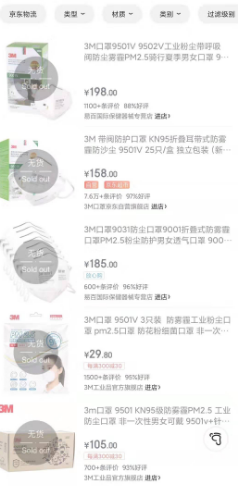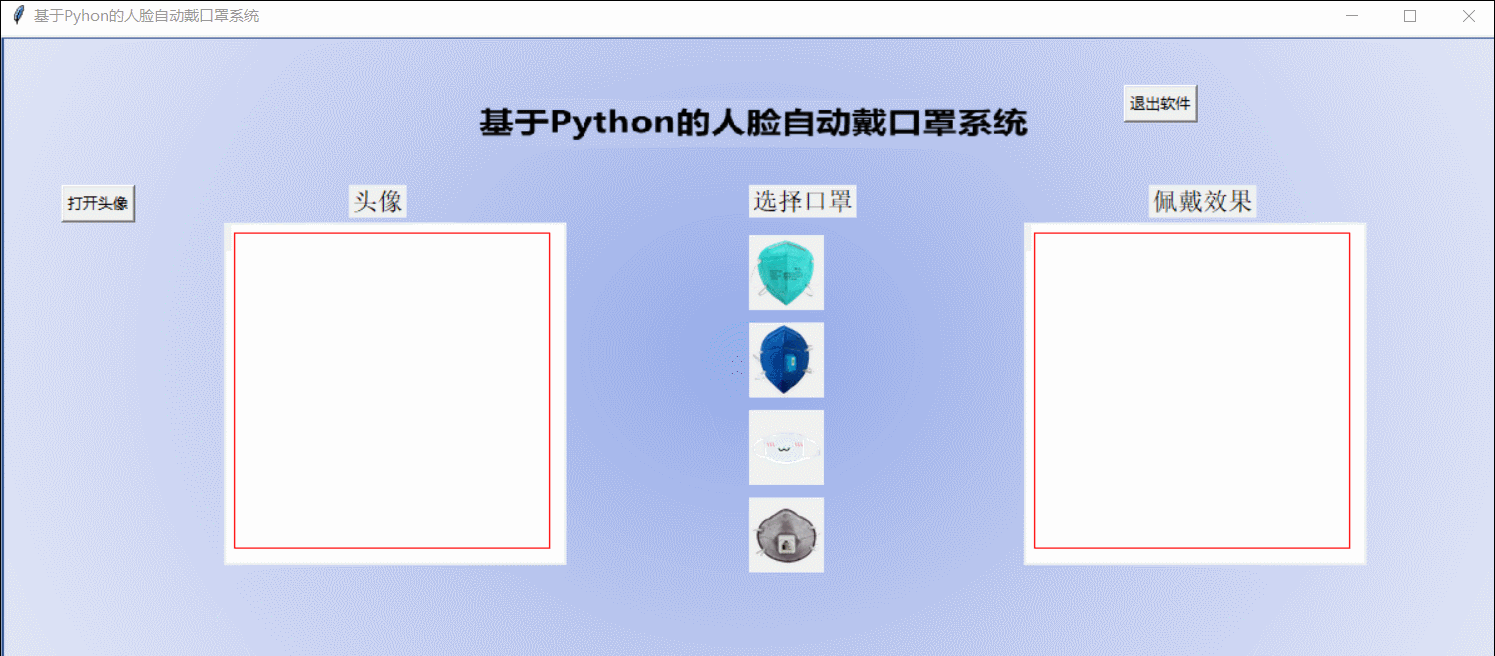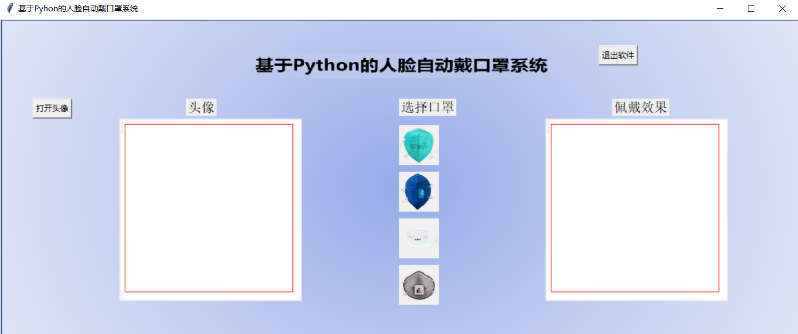项目背景
2019年新型冠状病毒感染的肺炎疫情发生以来,牵动人心,举国哀痛,口罩、酒精、消毒液奇货可居。

抢不到口罩,怎么办?作为技术人今天分享如何使用Python实现自动戴口罩系统,来安慰自己,系统效果如下所示:

本系统的实现原理是借助 Dlib模块的Landmark人脸68个关键点检测库轻松识别出人脸五官数据,根据这些数据,确定嘴唇部分的位置数据(48点~67点位置),根据检测到嘴部的尺寸和方向,借助PLL模块调整口罩的尺寸和方向,实现将口罩放在图像的适当位置。

页面设计
基于tkinter模块实现GUI设计,可载入人物图像,选择四种类型口罩(这里的口罩是处理好的图片),展示佩戴好口罩的效果,操作完成退出系统,效果如下所示:

页面布局实现代码如下所示:
def __init__(self): self.root = tk.Tk() self.root.title('基于Pyhon的人脸自动戴口罩系统') self.root.geometry('1200x500') self.path1_ = None self.path2_ = None self.seg_img_path = None self.mask = None self.label_Img_seg = None decoration = PIL.Image.open('./pic/bg.png').resize((1200, 500)) render = ImageTk.PhotoImage(decoration) img = tk.Label(image=render) img.image = render img.place(x=0, y=0) # 原图1的展示 tk.Button(self.root, text="打开头像", command=self.show_original1_pic).place(x=50, y=120) tk.Button(self.root, text="退出软件", command=quit).place(x=900, y=40) tk.Label(self.root, text="头像", font=10).place(x=280, y=120) self.cv_orinial1 = tk.Canvas(self.root, bg='white', width=270, height=270) self.cv_orinial1.create_rectangle(8, 8, 260, 260, width=1, outline='red') self.cv_orinial1.place(x=180, y=150) self.label_Img_original1 = tk.Label(self.root) self.label_Img_original1.place(x=180, y=150) tk.Label(self.root,text="选择口罩",font=10).place(x=600,y=120) first_pic = Image.open("./pic/Mask.png") first_pic = first_pic.resize((60, 60), Image.ANTIALIAS) first_pic = ImageTk.PhotoImage(first_pic) self.first = tk.Label(self.root, image=first_pic) self.first.place(x=600,y=160, width=60, height=60) self.first.bind("<Button-1>", self.mask0) second_pic = Image.open("./pic/Mask1.png") second_pic = second_pic.resize((60, 60), Image.ANTIALIAS) second_pic = ImageTk.PhotoImage(second_pic) self.second_pic = tk.Label(self.root, image=second_pic) self.second_pic.place(x=600, y=230, width=60, height=60) self.second_pic.bind("<Button-1>", self.mask1) third_pic = Image.open("./pic/Mask3.png") third_pic = third_pic.resize((60, 60), Image.ANTIALIAS) third_pic = ImageTk.PhotoImage(third_pic) self.third_pic = tk.Label(self.root, image=third_pic) self.third_pic.place(x=600, y=300, width=60, height=60) self.third_pic.bind("<Button-1>", self.mask3) forth_pic = Image.open("./pic/Mask4.png") forth_pic = forth_pic.resize((60, 60), Image.ANTIALIAS) forth_pic = ImageTk.PhotoImage(forth_pic) self.forth_pic = tk.Label(self.root, image=forth_pic) self.forth_pic.place(x=600, y=370, width=60, height=60) self.forth_pic.bind("<Button-1>", self.mask4) tk.Label(self.root, text="佩戴效果", font=10).place(x=920, y=120) self.cv_seg = tk.Canvas(self.root, bg='white', width=270, height=270) self.cv_seg.create_rectangle(8, 8, 260, 260, width=1, outline='red') self.cv_seg.place(x=820, y=150) self.label_Img_seg = tk.Label(self.root) self.label_Img_seg.place(x=820, y=150) self.root.mainloop()
载入人物图像,实现代码如下所示:
# 原图1展示 def show_original1_pic(self): self.path1_ = askopenfilename(title='选择文件') print(self.path1_) self.Img = PIL.Image.open(r'{}'.format(self.path1_)) Img = self.Img.resize((270,270),PIL.Image.ANTIALIAS) # 调整图片大小至256x256 img_png_original = ImageTk.PhotoImage(Img) self.label_Img_original1.config(image=img_png_original) self.label_Img_original1.image = img_png_original # keep a reference self.cv_orinial1.create_image(5, 5,anchor='nw', image=img_png_original)
人脸戴口罩展示,实现代码如下所示:
# 人脸戴口罩效果展示 def show_morpher_pic(self): img1 = cv2.imread(self.path1_) x_min, x_max, y_min, y_max, size = self.get_mouth(img1) adding = self.mask.resize(size) im = Image.fromarray(img1[:, :, ::-1]) # 切换RGB格式 # 在合适位置添加头发图片 im.paste(adding, (int(x_min), int(y_min)), adding) # im.show() save_path = self.path1_.split('.')[0]+'_result.jpg' im.save(save_path) Img = im.resize((270, 270), PIL.Image.ANTIALIAS) # 调整图片大小至270x270 img_png_seg = ImageTk.PhotoImage(Img) self.label_Img_seg.config(image=img_png_seg) self.label_Img_seg.image = img_png_seg # keep a reference
导入四种口罩图像,实现代码如下所示:
def mask0(self, event): self.mask = Image.open('pic/mask.png') self.show_morpher_pic() def mask1(self, event): self.mask = Image.open('pic/mask1.png') self.show_morpher_pic() def mask3(self, event): self.mask = Image.open('pic/mask3.png') self.show_morpher_pic() def mask4(self, event): self.mask = Image.open('pic/mask4.png') self.show_morpher_pic()
器官识别
页面功能实现后就是依托Dlib库实现人脸器官关键点的识别,分析出嘴部位置及尺寸,这里为了方便各位直观了解,写了一个测试Demo,将人物脸部关键点都显示出来,代码如下所示:
#coding=utf-8 #图片检测 - Dlib版本 import cv2 import dlib import time t=time.time() path = "./pic/im.jpg" img = cv2.imread(path) gray = cv2.cvtColor(img, cv2.COLOR_BGR2GRAY) #人脸分类器 detector = dlib.get_frontal_face_detector() # 获取人脸检测器 predictor = dlib.shape_predictor( "./shape_predictor_68_face_landmarks.dat" ) dets = detector(gray, 1) for face in dets: shape = predictor(img, face) # 寻找人脸的68个标定点 # 遍历所有点,打印出其坐标,并圈出来 for pt in shape.parts(): pt_pos = (pt.x, pt.y) cv2.circle(img, pt_pos, 1, (0, 255, 0), 2) cv2.imshow("image", img) print('所用时间为{}'.format(time.time()-t)) cv2.waitKey(0) #cv2.destroyAllWindows() time.sleep(5)
效果如下所示:

在本系统中这些关键点无需绘制显示,直接使用就可以,实现代码如下所示:
def get_mouth(self, img): img_gray = cv2.cvtColor(img, cv2.COLOR_BGR2GRAY) detector = dlib.get_frontal_face_detector() predictor = dlib.shape_predictor('./shape_predictor_68_face_landmarks.dat') faces = detector(img_gray, 0) for k, d in enumerate(faces): x = [] y = [] # 人脸大小的高度 height = d.bottom() - d.top() # 人脸大小的宽度 width = d.right() - d.left() shape = predictor(img_gray, d) # 48-67 为嘴唇部分 for i in range(48, 68): x.append(shape.part(i).x) y.append(shape.part(i).y) # 根据人脸的大小扩大嘴唇对应口罩的区域 y_max = (int)(max(y) + height / 3) y_min = (int)(min(y) - height / 3) x_max = (int)(max(x) + width / 3) x_min = (int)(min(x) - width / 3) size = ((x_max - x_min), (y_max - y_min)) return x_min, x_max, y_min, y_max, size
退出系统
退出系统非常简单,一行Demo即可实现,如下所示:
def quit(self): self.root.destroy()